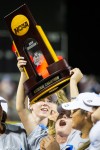As 12-year-old me sank deeply into the couch, snug in old gym clothes and fluffy slippers, my mother asked why I stayed up late watching weird Asian cartoons. My father, an avid fan of anime since his teens, urged me to finish binge-watching his “Dragon Ball Z*” tapes as he shooed my mother away. Nagging as she often did, my mother said these nonsensical, oftentimes inappropriate children’s shows were not worth the sleep deprivation.
Other women in my family, including three aunts, a grandma and a cousin, held a similar confusion toward my late-night hobby. The next morning – or any other morning for that matter – I had similar conversations with peers who also found my interest in anime to be strange.
Anime is to Japan as cartoons are to the U.S. Many anime series are based on manga*, or Japanese comics. Similar to how cartoons on Adult Swim have a different target audience than those produced by Nickelodeon, there are many subgenres in anime geared toward different demographics. Shojo* targets teenage girls and shonen* targets teenage boys. However, despite my fondness for a romantic sob story, I have been shonen-obsessed since the eighth grade.

As a girl often chastised for my sarcasm and smart aleck antics, the facetious humor present in anime entertained me more than any Disney show. Without knowing the word “cosplay,” I always wished to transform into a sword-wielding shinobi*. The thought of physically connecting to the on-screen world through costume and role play made the wait for Halloween nearly unbearable. But even though anime consumed my thoughts during the day, there was no one to share my enthusiasm with.
For most of my adolescence, my seemingly peculiar hobby made me feel out of sync with my community. But well before this interest began to bud, I had already found it difficult to fit in with those around me.
I seemed to stand out from the girls around me, who had no trouble pointing out what prevented me from being one of them. From being told I “talked too white” or “didn’t dress like a black girl,” there was always something about the way I carried myself that wasn’t “black enough.” Even my mom often wished I had a greater affinity toward our culture – secretly hoping I’d watch episodes of “The Proud Family” instead of a shonen.
Regardless of the taunts of my classmates or my mother’s dismay, I never longed to change who I was or what I enjoyed. In hindsight, the otherness I felt within my own community is one of the forces that attracted me to anime in the first place. And as I grew more engrossed in the medium, it only reinforced my identification as an outsider.
Then at the age of 16, I came across #28DaysOfBlackCosplay, a social media campaign held in February to promote the work of black cosplayers. And so began my rapid plunge into the accounts of black women who shamelessly expressed their love for anime, winding downward into a network of melanated* otakus*. These women managed a feat that I had thought impossible: carving a space in which one can publicly love anime while being black and feminine.
Having grown up before the widespread usage of social media, Eunice Ibama, who runs @blackgirlsanime on Instagram, didn’t think many other black women watched anime regularly. As someone who was bullied for her interest while growing up, Ibama said her page and the women it allowed her to meet helped bring her out of a state of depression.
“I was in a really depressed state when I first started this page. Then I set it up and started talking about my love for anime, and people just started coming out of nowhere,” Ibama said. “I didn’t think this many black women, black men … watched anime. It was mind blowing to me.”
Currently, Ibama runs an Instagram account with nearly 25,000 followers, and she said she constantly receives messages from black women telling her they feel less lonely after finding this platform in which they can explore their passions within their community.
Like Ibama, I never held stock in the idea that there were other anime fans that looked like me. In my experience, a youthful brown face is not the first one imagined when the anime fandom – or any “nerdy” fandom – is mentioned. Oftentimes, people I speak with face to face, whether they are anime fans or not, are surprised when I mention “Naruto.*” They unknowingly convey through their widened eyes that this hobby is somehow uncharacteristic.

Whether it is my complexion or gender that convinces others that I would not favor a gory shonen series, such as “Attack on Titan,*” there seems to be something about my appearance that contradicts watching anime in the minds of others. Albeit, I am used to being held subject to certain stereotypes. But, it seems odd for these misconceptions to pervade the niche of anime.
To Jamie Broadnax, founder of the blog Black Girl Nerds, it is the limited range and quality of black women representation in the entertainment industry, including anime, that strengthens this misconception. Through recycling the stereotype of the stubborn, strong black woman, this image eventually gets ingrained into public perception and internalized by all who watch. Broadnax founded her site as a gathering place for “blerds*” – black individuals whose interest and personalities lie outside the tropes that are typically portrayed in media.
Broadnax’s explanation reminded me of when I used to search for myself on the screen as a child. Typically, there was exactly one of me on every show, and if not me, then one of my brother. But even when I did find a character who resembled my likeness, her personality was far from mine. I don’t roll my neck as I speak, and I don’t speak louder than everyone around me. Libby in “The Adventures of Jimmy Neutron: Boy Genius” was too sassy and Raven Baxter was too meddlesome. Not only did my classmates think I wasn’t black enough, but neither did Nickelodeon or Disney or Hollywood.
“Black women are seen to be hard, self-sufficient, sassy, … but we can also be soft and also be the princesses,” said Jacque Aye, the founder of lifestyle brand Adorned by Chi.
In hopes of catering to black women who don’t see their personality or interests represented in media, Aye produces merchandise and manga for soft, black girls.
Aye said she wanted to promote the strength and existence of magical*, melanated women with interests and temperaments that aren’t stereotypically attributed to their appearance. Through shirts that read “Solange is my Patronus” and “I Call My Man Hokage,” Aye’s everyday apparel is a daily reminder of the presence of black women in nerd culture.
Although I used anime to escape from my discomfort with American media, the same issues arose in Japanese shows, whether I watched Saitama half-heartedly train his cyborg companion in “One Punch Man” or Usagi Tsukino transform into the cute and girly Sailor Moon*. Even these shows that kept me from sleeping didn’t feature characters resembling myself.
When there was a black figure in an anime, the character was rarely both prominent and inoffensive. Images of charcoal-skinned, fat-lipped men bumbling across the screen occasionally stained the moments I spent watching “Dragon Ball Z” with my father. When I asked how he could still watch the show in spite of the racist caricatures, he shrugged as if to say, “It is what it is.”

Lauren Vincent, a fourth-year art student, said she also used to ignore the bigoted animation style and characterization of black characters. She said she reconciled this bad aspect of anime with all that was good. But once she gained more confidence and respect for herself, she realized that staying complacent with the way things were would do nothing to make them better. Vincent said she takes a stand by refusing to watch anime with harmful depictions of black characters, all the while promoting black cosplay and art on her Instagram page.
Like Vincent, I found ways to rationalize the misrepresentation of black characters in anime. Yes, some animated characters are bigoted – even appalling, at times – representations, but so are some American ones. It’s one thing for a foreign country to wrongfully portray me on screen, but it’s another for my own to do so.
It’s similar to how I didn’t care nearly as much when a stranger scolded me as opposed to my mother doing so. Anime was the distant foreigner who didn’t have to care about me. But as I’ve grown up, I’ve realized that there is no justification for the disrespect of my community.
Thankfully, there are a few good black-coded or black characters out there, such as Killer B from “Naruto: Shippuden” and Canary from “Hunter x Hunter.” Contrary to the usual attribution of aggression or feeblemindedness to large black men in media, shinobi Killer B prefers to use words rather than his fists. In men like Killer B, I am able to see my father and uncles instead of caricatures – strong men with the capability to both protect and empathize. Canary is the epitome of a soft black girl, possessing a shy demeanor and delicate voice. Unlike the Libbys and Ravens, Canary displays her strength through action as opposed to attitude-ridden remarks. I want more characters like these, that I can identify with.
Even though the lack of black characters didn’t prevent me from leaping into the anime fandom, others are reluctant to support a medium that does not support them. Lauren Smith, secretary of Japanese Animation Club at UCLA, said she has trouble convincing her friends to attend conventions due to the limited amount of dark-skinned characters to cosplay. Even though many black women dress as characters of other ethnicities, Smith said her friends believe that representation is key – especially when it comes to cosplay.
And for black women who do wish to cosplay all types of characters, there is still pressure to cosplay a character that they resemble. Although I’m a cosplay novice, I have always been one to dress up for the occasion. Every Halloween, costume parties, the premiere of “Black Panther” – for each event, I spent time researching the disguises I hoped to don for the evening. But regardless of the event, there was always a nagging fear that I couldn’t successfully impersonate a character that had lighter skin.

So, I dressed as Dionne from “Clueless” instead of Cher, as Numbuh 5 from “Codename: Kids Next Door” instead of Numbuh 3. There was a box that I confined myself in, believing it to be the only space in which I could look the part. If I don’t have the same complexion and hair texture as the character, how could I possibly masquerade as her?
This misconception concerning the ability of black women to cosplay nonblack characters also affected Kiera Brown, who runs Instagram account @kieraplease, when she started to cosplay. She said people’s negative comments on social media used to prevent her from cosplaying as slim-figured, lighter-skinned characters.
But it is impossible for anyone to have a perfect cosplay, since the characters are fictional. Once Brown realized this, she said she felt free to reimagine characters to fit her hair and curves and everything else that makes up who she is.
In the same way Brown shows off her figure in her cosplays, Shellanin, known as “the curly cosplayer” and @shellanin_ on Instagram, also adds an element of representation to her costumes. Through curly-haired renditions of anime characters, Shellanin said she aims to normalize black hair by integrating it into her costumes. Transforming Elastigirl’s signature bob into a curly fro and Super Saiyan spikes into a textured puff allows Shellanin to infuse a bit of herself into these characters.
People cosplay for myriad reasons: to escape from reality, delve into a fake world, better connect with a character. I want to cosplay to enter the life of a character, reimagined through my eyes.
I will cosplay for the first time at the San Jose FanimeCon in May – realizing the character transformations I wished for as a child.

Within my community of black, female otakus, I can feel like myself regardless of what I do. I belong to a community of women who, like myself, didn’t entertain the notion of there being thousands just like them before entering into this space. Yet, I am hesitant to step outside the blerd community. Inside this bubble, I can discuss ship names and American release dates and the unholy amount of boob jiggles in every shonen series ever. I can dress up without having to straighten my hair or contour my nose.
At the convention, I will meet a sea of people from different cities, subfandoms and nationalities. While many of these strangers are bound to be pleasant, there is still a chance that I will be subject to unwarranted stares and biased perceptions. I will be scanned and subsequently judged by those who can’t relate to my story, and some who wouldn’t even care to. My cosplay of a white character will be seen as imperfect, or my cosplay of a black character will be seen as mandated.
But my cosplay, forged from the wisdom bestowed onto me by the frontrunners of the blerd community, will serve as my armor. Something that is fierce and representative. A character who can be badass and refined at the same time. A black character who subverts the intolerant tropes and carves out a persona for herself. A sultry death weapon from “Soul Eater,*” Mira Naigus.

And while I’d like to think I’ve come a long way from the isolated, closed-off girl I was years ago, it’s easy to understand what forces in my life pushed me to that place. But after weeks of conversations with the women who pulled me from isolation, I recognized a common theme in their stories: At the end of the day, you have to allow yourself to be comfortable in spaces that weren’t originally made for you. Despite being 19 in college now, a part of me still feels like that 12-year-old who was eager to belong but didn’t. But the older I’ve gotten, the more I understand that it’s better to be myself and the odd one out than to masquerade as someone else to fit in.
But, it shouldn’t have taken a chance encounter with a Twitter account for me to be exposed to other women like myself. It was difficult to find a community that I never knew existed – it was something I casually stumbled upon. But I can imagine that there are other girls who haven’t been so lucky. Until there is more depiction of black women in the dominant fandom, blackness and anime will continue to be seen as generally incommensurable.
I am a black girl and an otaku, and I’m proud to be both. Being black does not prevent me from watching anime and watching anime does not detract from my blackness. After I found a hub of black women who are nerdy and soft at times and strong-willed at others, it became clear that there is no standard of “black enough” that I must ascribe to. I have friends now who love Cardi B just as much as they love Usagi. Friends that relate to the loneliness of my childhood and the biases I face in the present.






